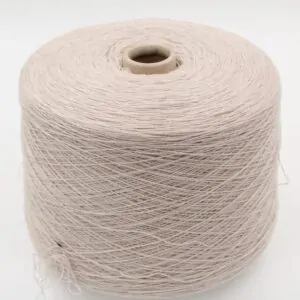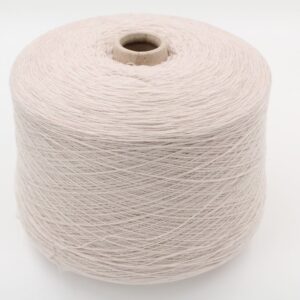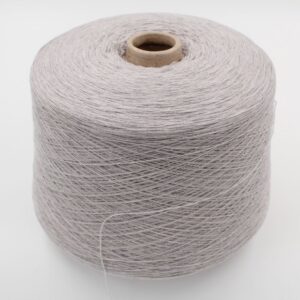How to work with untreated cashmere yarns

 Cashmere machine knitting yarns and cashmere yarns for hand knitting on cones are never treated (or almost never) and must be treated (washed) after processing. This is because knitting untreated yarn is much simpler, and there is less risk of the thread breaking or the machine needles breaking.
Cashmere machine knitting yarns and cashmere yarns for hand knitting on cones are never treated (or almost never) and must be treated (washed) after processing. This is because knitting untreated yarn is much simpler, and there is less risk of the thread breaking or the machine needles breaking.
My first and most important advice is always to make a small sample/sheet (10×10 or better 20×20) and wash it in the washing machine before carrying out the final work.
This is because cashmere yarns, even if they have the same count (fineness), are never all the same. There are many variables in the production of cashmere yarns, starting from spinning up to dyeing.
First of all, each spinning mill has its own method and its own market needs and the yarns can be harder or softer and also have a different dye. Furthermore, there is also a difference between yarns from the same spinning mill, based on colours; the lighter colors are different from the darker colors and melange colors and require small precautions in machine processing and in the first wash.
For example, darker colors will always be cruder (less soft) than light colors as more invasive fixing products are used in dyeing and fixing the color to ensure that the yarn does not lose its color during washing and over time but the fiber itself is affected in softness.
The type of machining also has an impact. Cashmere tends to swell when washed and needs sufficient space for this, so if you want to achieve maximum softness you tend to work it with a slightly looser knit.
On the contrary, if you want to obtain maximum resistance, especially in terms of pilling (the classic pilling that cashmere sweaters produce), you tend to knit it in tighter stitches. Thus you will obtain a less soft shirt, a little heavier, but much more resistant to pilling.
Below are our washing tips:
Premises:
1 – Sometimes it may be necessary to steam the sample and the garment before or after washing. Steaming means passing the iron, releasing the steam on the sample and/or the garment WITHOUT placing the iron on the sample/garment, before or after washing.
2 – The following washing recommendations are generic and basic. Before washing the sample, measure it, so you can calculate the indentations/shrinkages. Furthermore, carefully check the yield of the sample also in terms of softness and pile, so you will be able to see if it is appropriate to work it tighter or more sparsely, or whether to wash it a little more or a little less; in fact, if you work it too tightly, the cashmere will not release its full softness as it tends to swell and if you wash the sample/garment less you will get less hair and less softness, vice versa if you wash it for longer in the washing machine. To get more hair, increase the spin, but be careful not to overdo it. If necessary, make more samples and more washing tests, with tighter and sparser machine (or hand) processes and with different washing times.
3 – All of the above also applies to hand-knitted or crocheted yarns.
WASHING MACHINE TREATMENT:
Machine washing is done when you machine untreated yarn. The wash indicated is very delicate and the presence of vinegar will be an excellent descaler:
– Machine wash at 30° for 7 minutes with very little detergent for delicate items
– Rinse the washing machine
– Machine wash at 30° for 7 minutes with very little fabric softener and 1/4 measuring spoon of white wine vinegar (not red vinegar because it stains).
– Centrifuge at 400 rpm for 5 minutes (or as little as possible)
– Dry flat without exposing to direct sunlight and without wringing the garment (otherwise you risk deforming it)
– For strong and contrasting colors in striped and jacquard knitwear we recommend carrying out an initial dry cleaning and washing the garments half a load with plenty of water.
This washing procedure is valid whether it is a sample, finished garment or yarn itself.
ATTENTION: This washing procedure should only be carried out the first time, subsequently it is recommended to wash the items by hand following this procedure:
If you want your sweater to always remain soft and fluffy, follow these tips:
Soak it in warm water with a delicate detergent (use very little), adding a little white wine vinegar in case of scratches or bright colors.
Leave it to soak for a short time, ten to fifteen minutes at most.
Don’t rub it and handle it gently.
Rinse it patiently several times and with lots of water, always lukewarm, until the water is perfectly clear.
Don’t wring it out but remove the water by pressing gently.
Wrap the sweater in a terry cloth or towel to eliminate excess water.
Spread it out on a flat surface horizontally, taking care to avoid direct exposure to the sun.
Let it dry at room temperature, never near a heat source.
Iron it with a strong jet of steam without placing the iron on the sweater.







